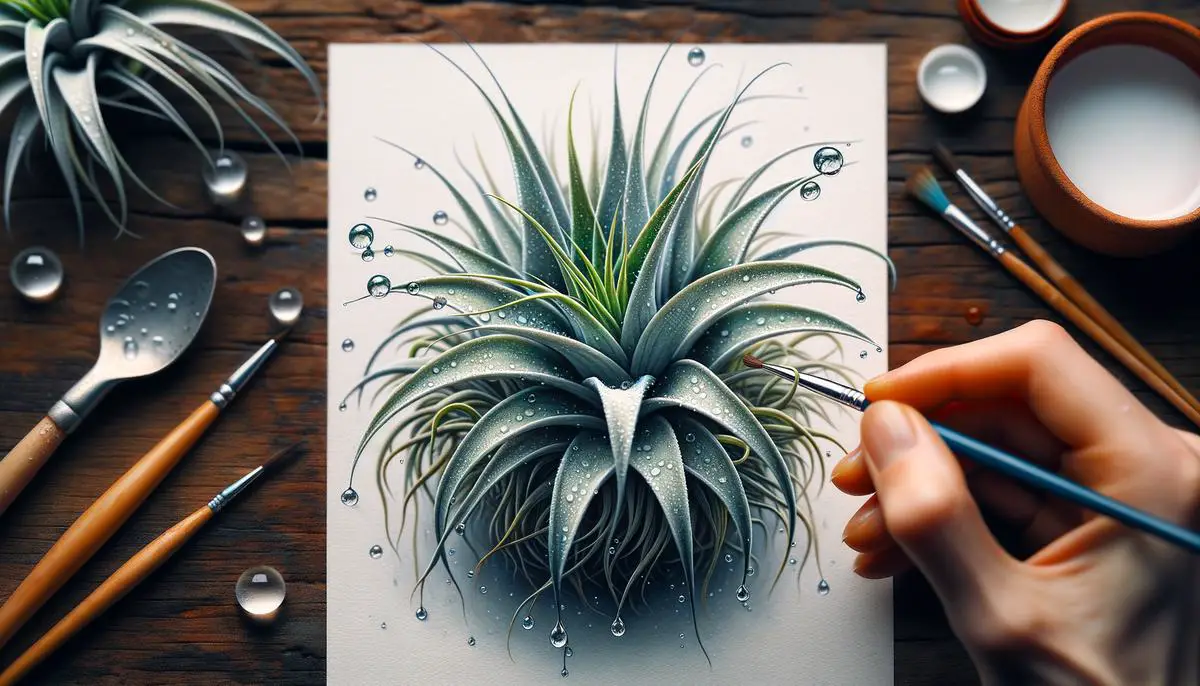Optimal Watering Guide for Air Plants: How Often to Water?

Air plants, or Tillandsia, offer a unique twist to the indoor garden scene. These soil-free wonders absorb moisture and nutrients through their leaves, making them an intriguing choice for enhancing your living space. This article will explore the fascinating way air plants meet their watering needs and how you can ensure they thrive under your care.
Understanding Air Plant Watering Needs
Understanding How Air Plants Drink
Air plants have special structures on their leaves called trichomes. Trichomes look like tiny scales or hairs and act a bit like sponges, soaking up water from the air. If you’ve ever noticed your air plant taking on a silver or more vibrant look after watering, that’s the trichomes in action!
Since air plants don’t stick their roots in the ground, they rely on those trichomes to grab onto the moisture they need. This quirky feeding method means that even though Tillandsia are air plants, they still need water to thrive. They’re not completely care-free (sorry!), but keeping them happy doesn’t require a green thumb.
Here’s How to Water Your Air Plants Correctly
Because air plants depend on their leaves to suck up that essential moisture, dunking them in water or giving them a nice soak is the way to go. Remember, spraying them lightly with a mist can refresh them, but it’s like offering a sip when they’re really craving a big gulp of water. Trust me, to keep them perky, soaking is key.
- Get Set for a Soak: Pick a container that’s clean and fill it with water. Rainwater or filtered water is like gourmet to them, but if tap is all you’ve got, just let it sit out overnight to evaporate any harsh chemicals like chlorine.
- Bath Time: Plunge your air plants into the water. Make sure most of each plant gets submerged but don’t sweat it if they float a bit.
- Time It: Leave your green friends to soak in their bath for about an hour. Think of this as their spa time; it’s crucial for sucking up enough H2O.
- Dry Them Off: After their soak, shake them gently to get rid of excess water hiding in their leaves – you don’t want them getting all soggy and unhappy. Then, place them on a towel in a spot with enough air flow to dry out within a few hours.
Keep Them Happy All Year Round
Your air plants will want a soaking session about once a week during those hot summer days when they’re soaking up the sun (yes, they love indirect bright light too!) and every few weeks in the cold of winter. Just like us, they’re not too keen on being cold and wet.

Soaking vs. Misting: Finding the Balance
Soaking is like giving your air plants a mini-vacation, a deep drink to quench their thirst. Here’s the scoop: once a week, dunk your air plants in a bath of room temperature water. Let them chill there for about an hour. Think of it as their spa time! After the soak, ensure you shake off any excess water. This step is super important to prevent any soggy conditions that could lead to rot. Let them dry in a spot with some good airflow. A gentle reminder – soaking is superb for ensuring the core and every leaf gets hydrated, pushing your plants to thrive.
If your environment is on the drier side, give your air plants a spritz between their soaking sessions. You’re aiming for 2-3 times a week, just enough to keep them from going thirsty. But remember, misting is more of a supplement to soaking, not a replacement.
Here’s the deal: soaking quenches their deep thirst, and misting keeps them from getting parched in between. Every plant will show you signs of what they need, so keep an eye out. These little guys are tough but rely on you to mimic their natural damp, airy homes. Stick to the plan – soak weekly, mist 2-3 times a week, and you’ll have happy air plants brightening up your space. And always remember, after any water party, make sure your air plants are good and dry before tucking them back into their favorite nooks.

Recognizing Signs of Over or Under-Watering
Telling if Your Air Plant is Over or Under-Watered and What to Do
Sometimes, your air plant gives you a sign, kind of like a signal, saying, “Hey, I need more water,” or “Whoa, ease up on the water!” But how do you figure out which is which? Let’s break it down.
Signs Your Air Plant is Thirsty (Under-Watered)
- Curled Leaves: If you see the leaves curling up tighter than a spiral curl, your air plant is shouting for a drink.
- Brittle Texture: The leaves feel more like paper and less like a healthy plant.
- Dull Color: That vibrant green takes on a more gray or brown tone.
- Tips Turning Brown: Picture the tips of your plant’s leaves looking like they’ve been dipped in light brown paint.
What to Do: Give it a soak! Yep, a nice 1-hour bath in room-temperature, non-chlorinated water should help. Just make sure to shake off the excess and let it dry well in a bright spot.
Signs Your Air Plant Has Too Much Water (Over-Watered)
- Leaves Falling Off: This isn’t autumn for air plants. If leaves start dropping like it’s fall, it’s a red flag.
- Rotting Smell: If you get near your plant and it reminds you of something gone bad, that’s rot.
- Soft Base: When the base feels like a squishy pillow, trouble’s brewing.
- Black or Brown Base: It might look cool in a gothic sense, but it means disaster for your plant.
What to Do: It’s sort of like putting a superhero on timeout. Pause on watering. If anyone can bounce back, it’s your air plant. Just move it to a super bright spot and give it some time. You can trim off any parts that look too far gone. Love, patience and a little plant pep talk will go a long way.
Remember these signs and responses to adjust your care routine. Your air plant depends on you to mirror the rainforest vibes it craves, minus the actual forest. Create a little schedule reminder if needed, and soon, watering your air plant will be as routine as scrolling through your phone—easy and on autopilot.

By now, you should have a solid grasp on the essentials of air plant care, particularly when it comes to meeting their watering needs. Remembering to soak them regularly while adjusting for seasonal changes ensures they remain vibrant and healthy.
Observing your air plants closely will let you respond promptly to any signs of distress, whether from too little or too much water. With these guidelines in hand, you’re well-equipped to provide the best care for these remarkable plants, ensuring they continue to brighten up your home with minimal fuss.
REFERENCE
- Benzing DH. Bromeliaceae: profile of an adaptive radiation. Cambridge: Cambridge University Press; 2000.
- Benz MB, Martin CE. Foliar trichomes, boundary layers, and gas exchange in 12 species of epiphytic Tillandsia (Bromeliaceae). J Plant Physiol. 2006;163(6):648-656.
- Zotz G. The systematic distribution of vascular epiphytes – a critical update. Bot J Linn Soc. 2013;171(3):453-481.
